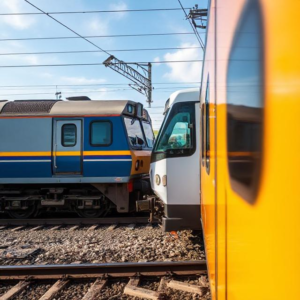Advanced Signaling Techniques for High-Speed Rail are technologies that help trains travel at very fast speeds while ensuring safety, efficiency, and smooth operation. High-speed trains need specialized signaling systems because they travel much faster than regular trains, and there’s less time to react if something goes wrong. Let’s break it down in simple terms:
1. Why Are Advanced Signaling Systems Needed for High-Speed Rail?
High-speed trains travel at speeds above 155 mph (250 km/h) or more. At such high speeds, traditional signaling systems aren’t fast or accurate enough. Advanced signaling systems are required to:
- Ensure Safety: Prevent accidents like collisions or derailments.
- Handle High-Speed Traffic: Make sure the trains move quickly and efficiently without delays or mistakes.
- Provide Precise Control: Ensure that signals are quick, accurate, and responsive.

2. Key Features of Advanced Signaling for High-Speed Rail
Here are some of the key techniques used in high-speed rail signaling:
a. Communication-Based Train Control (CBTC)
CBTC is a modern signaling system used for both high-speed and metro trains. It relies on continuous communication between the train and the control center via radio signals. Here’s how it works:
- Real-Time Updates: Instead of relying only on fixed signals (like traffic lights on the tracks), CBTC sends continuous updates to the train about its location, speed, and whether it can continue moving.
- Automatic Speed Adjustment: CBTC can automatically slow the train down or stop it if it’s going too fast or approaching an obstacle. This helps prevent accidents.
b. European Train Control System (ETCS)
ETCS is a signaling system specifically designed for high-speed trains in Europe. It uses a combination of onboard equipment and trackside signals to keep trains running safely and on schedule. There are different levels of ETCS, with the higher levels being used for high-speed trains:
- Level 1: Uses traditional trackside signals and communicates with the train through trackside equipment.
- Level 2: Provides continuous communication between the train and control center, and the train doesn’t rely on trackside signals at all. This system can handle higher speeds.
- Level 3: An even more advanced version that uses satellite technology and sensors to track trains in real time. It provides very precise control and is used for ultra-high-speed systems.
c. Moving Block Signaling
Traditional signaling uses “fixed blocks,” where the track is divided into sections. Trains must wait for the section ahead to clear before moving forward. This can slow down high-speed trains. Moving block signaling is different:
- No Fixed Blocks: Instead of dividing the track into fixed sections, the “block” moves with the train. The distance between trains is adjusted based on their speed.
- Increased Capacity: Since the block moves, trains can travel closer together without risk of collision, allowing for more trains on the track and smoother operation.
d. Satellite-Based Positioning
High-speed trains use satellite systems, like GPS, to track their position with high accuracy. This helps with:
- Tracking the Train’s Location: The train’s exact position is continuously updated, so the signaling system knows where it is at all times.
- Improved Control: With precise location data, the system can control the train’s speed and braking more effectively, ensuring smooth travel even at high speeds.
e. Automatic Train Operation (ATO)
ATO is an automation system that controls the train’s movement. It works alongside the signaling system and is used in high-speed rail to:
- Control Train Speeds: The ATO system automatically adjusts the speed of the train based on the signals and track conditions.
- Stop and Start: ATO can automatically start and stop the train, reducing the risk of human error.
3. How These Systems Work Together
Advanced signaling techniques for high-speed rail work in harmony to keep trains moving quickly and safely:
- Real-Time Communication: Systems like CBTC and ETCS use continuous communication between the train and the control center to update the train’s speed, location, and the status of the track ahead.
- Speed Control and Safety: The system ensures that the train maintains the correct speed, slowing down if necessary to avoid dangers or accidents.
- Improved Capacity and Efficiency: Techniques like moving block signaling and satellite-based positioning allow more trains to travel safely on the same tracks, increasing the efficiency of the system.
4. Why These Techniques Are Important
- Safety at High Speeds: High-speed trains are going much faster than regular trains, so safety is a top priority. These advanced systems ensure the trains stay on track and avoid accidents.
- Reduced Delays: Because the systems can automatically control speeds and manage traffic, trains can move more efficiently without waiting for manual signal changes.
- Future-Proofing: As train speeds increase in the future, these advanced techniques will allow rail networks to keep up with the demand for faster and more reliable services.
5. Advantages of Advanced Signaling Systems for High-Speed Rail
- Higher Speed Limits: With precise control, high-speed trains can travel at their maximum speeds safely.
- Less Human Error: Automated systems like ATO reduce the chances of mistakes by train drivers or operators.
- More Trains on the Track: Techniques like moving block signaling and satellite tracking allow more trains to run on the same tracks without compromising safety.
- Faster Recovery from Delays: If there’s an issue (like a delay or signal failure), the system can respond quickly to adjust schedules and avoid further delays.
Conclusion
Advanced signaling systems for high-speed rail are crucial for keeping trains running safely and efficiently at very fast speeds. Technologies like CBTC, ETCS, satellite-based positioning, and moving block signaling provide real-time communication, automatic speed adjustments, and improved safety, all while allowing for more trains to run on the same tracks. These systems ensure high-speed rail can deliver fast, reliable, and safe travel for passengers.
Keywords: Railway Data Analytics, Railway











